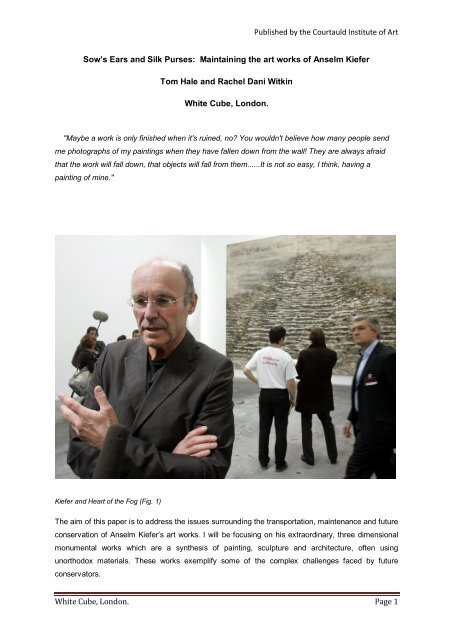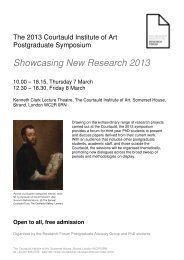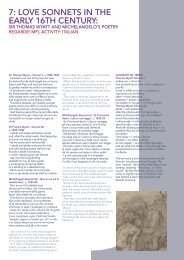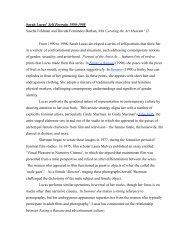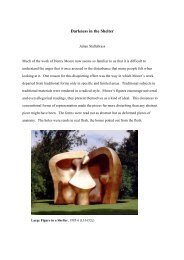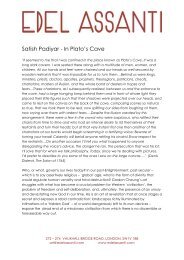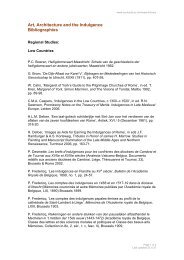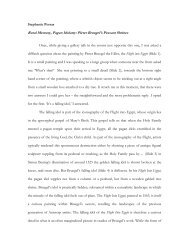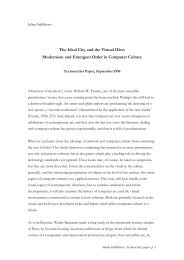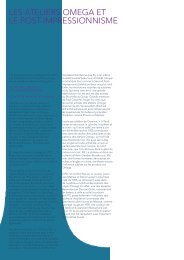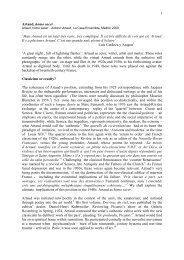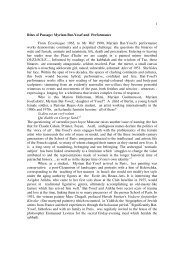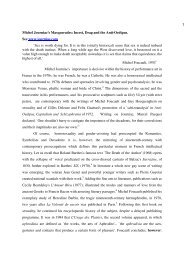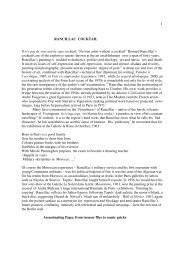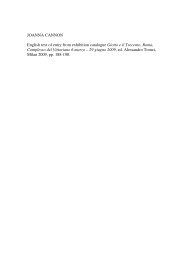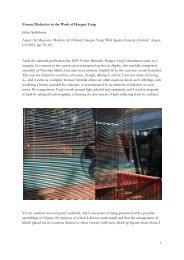Sow's Ears and Silk Purses - The Courtauld Institute of Art
Sow's Ears and Silk Purses - The Courtauld Institute of Art
Sow's Ears and Silk Purses - The Courtauld Institute of Art
Create successful ePaper yourself
Turn your PDF publications into a flip-book with our unique Google optimized e-Paper software.
Published by the <strong>Courtauld</strong> <strong>Institute</strong> <strong>of</strong> <strong>Art</strong><br />
Sow’s <strong>Ears</strong> <strong>and</strong> <strong>Silk</strong> <strong>Purses</strong>: Maintaining the art works <strong>of</strong> Anselm Kiefer<br />
Tom Hale <strong>and</strong> Rachel Dani Witkin<br />
White Cube, London.<br />
"Maybe a work is only finished when it's ruined, no? You wouldn't believe how many people send<br />
me photographs <strong>of</strong> my paintings when they have fallen down from the wall! <strong>The</strong>y are always afraid<br />
that the work will fall down, that objects will fall from them......It is not so easy, I think, having a<br />
painting <strong>of</strong> mine."<br />
Kiefer <strong>and</strong> Heart <strong>of</strong> the Fog (Fig. 1)<br />
<strong>The</strong> aim <strong>of</strong> this paper is to address the issues surrounding the transportation, maintenance <strong>and</strong> future<br />
conservation <strong>of</strong> Anselm Kiefer’s art works. I will be focusing on his extraordinary, three dimensional<br />
monumental works which are a synthesis <strong>of</strong> painting, sculpture <strong>and</strong> architecture, <strong>of</strong>ten using<br />
unorthodox materials. <strong>The</strong>se works exemplify some <strong>of</strong> the complex challenges faced by future<br />
conservators.<br />
White Cube, London. Page 1
Published by the <strong>Courtauld</strong> <strong>Institute</strong> <strong>of</strong> <strong>Art</strong><br />
<strong>The</strong> huge painting ‘Nebell<strong>and</strong> hab ich gesehen, Nebelherz hab ich gegessen für Ingeborg Bachman’,<br />
[‘I have seen the L<strong>and</strong> <strong>of</strong> the Fog, I have eaten the Heart <strong>of</strong> the Fog’] (1997) journeyed from Kiefer’s<br />
Barjac studio in the South <strong>of</strong> France, to the Gr<strong>and</strong> Palais, Paris in 2007, back to Barjac <strong>and</strong> then on to<br />
White Cube, London in 2008. ‘Heart <strong>of</strong> the Fog’ is the size <strong>of</strong> the front <strong>of</strong> a semi-detached house<br />
(570cm x 800cm). Due to their size, scale <strong>and</strong> the nature <strong>of</strong> the materials from which they are made,<br />
works such as this will inevitably change; there are liable to be ‘losses’ when they are transported.<br />
Curatorial image <strong>of</strong> Heart <strong>of</strong> the Fog (Fig.2)<br />
When ‘Heart <strong>of</strong> the Fog’ was installed at White Cube in 2008, Kiefer made a significant intervention<br />
that provides some insight into how the artist <strong>and</strong> gallery work together, <strong>and</strong> also how White Cube<br />
records the artist’s work, methods <strong>and</strong> intentions for future reference.<br />
Even with the benefit <strong>of</strong> a ‘hotline’ to the artist however, the gallery still has to make independent<br />
decisions about material losses which occur. Fig.3 is a photograph <strong>of</strong> what we call ‘Moon rocks’.<br />
<strong>The</strong>se are chunks <strong>of</strong> paint <strong>and</strong> shellac mixed with s<strong>and</strong>, glue <strong>and</strong> ash; small losses from the surface<br />
<strong>of</strong> the work, each approximately 2-3cm. Deciding whether, <strong>and</strong> where to re-adhere them onto the<br />
painting’s surface, or whether to archive them, presents a challenge.<br />
White Cube, London. Page 2
Kiefer moon-rocks (Fig.3)<br />
Published by the <strong>Courtauld</strong> <strong>Institute</strong> <strong>of</strong> <strong>Art</strong><br />
Before discussing Kiefer’s works <strong>and</strong> examining ‘Heart <strong>of</strong> the Fog’s’ journey in greater detail, I will<br />
provide some general background to the artist’s life <strong>and</strong> work. It is useful to consider his sources <strong>and</strong><br />
methods when approaching the issues surrounding the conservation <strong>of</strong> his art. As we come to<br />
underst<strong>and</strong> more about the multiple possibilities inherent in Kiefer’s materials <strong>and</strong> in the symbols he<br />
uses, as well as the role played by the passage <strong>of</strong> time, it becomes clear that the conservation <strong>of</strong> his<br />
work requires a ‘holistic’ approach; one that looks beyond conventional norms <strong>of</strong> ‘preservation’.<br />
<strong>The</strong> importance <strong>of</strong> knowledge<br />
Kiefer has been an avid student throughout his life <strong>and</strong> the breadth <strong>of</strong> his studies is evident in his<br />
work. He initially studied law <strong>and</strong> then went on to study art at the Dusseldorf Karlsruhe Academy,<br />
under the pr<strong>of</strong>essorship <strong>of</strong> Joseph Beuys. Kiefer has accumulated a wealth <strong>of</strong> knowledge about the<br />
White Cube, London. Page 3
Published by the <strong>Courtauld</strong> <strong>Institute</strong> <strong>of</strong> <strong>Art</strong><br />
ancient <strong>and</strong> modern worlds including Teutonic history, Gnosticism, Mysticism, Jewish Kabbalistic lore,<br />
philosophy, political theory <strong>and</strong> Alchemy. He has also travelled extensively.<br />
<strong>The</strong> preservation <strong>of</strong> knowledge is an important theme for Kiefer, who inscribes words in the form <strong>of</strong><br />
poetry, quotes, names <strong>and</strong> tributes to the works <strong>of</strong> other artists on his paintings <strong>and</strong> sculptures. In an<br />
interview with the artist, Michael Auping observed that the orientation <strong>of</strong> his works only becomes fixed<br />
when he writes on the canvas. Kiefer replied that his writing is ‘an attempt to fix a moment or place to<br />
suggest a fixed state, but the imagery denies, it is active i .’<br />
Kiefer making an inscription on Velimir Chelebnikov (Fig.4)<br />
In Kiefer’s work knowledge is contained within the protective lead covers <strong>of</strong> books which are stacked<br />
in sculpted bookshelves. As a German artist born in 1945, just before the end <strong>of</strong> World War II, Kiefer<br />
is pre-occupied with his own recent history <strong>and</strong> the Nazi regime, under which many books were<br />
denied or destroyed.<br />
White Cube, London. Page 4
History <strong>and</strong> memory<br />
Sculpture, Dane 2007 (Fig.5)<br />
Published by the <strong>Courtauld</strong> <strong>Institute</strong> <strong>of</strong> <strong>Art</strong><br />
A great deal has been written about Kiefer’s relationship to the Holocaust, particularly in his early<br />
work which focused heavily on the exploration <strong>of</strong> German identity. Like the poets Ingeborg Bachman<br />
<strong>and</strong> Paul Celan who have influenced his work, Kiefer grappled with the problem expressed by Adorno<br />
in the statement: ‘After Auschwitz to write a poem is barbaric’. ii<br />
<strong>The</strong> ephemeral nature <strong>of</strong> many <strong>of</strong> the materials that Kiefer uses challenges the mythology <strong>of</strong><br />
permanence that was propagated through the art <strong>and</strong> architecture <strong>of</strong> Fascism. Kiefer is also<br />
concerned with the dangers <strong>of</strong> looking only to the future after the holocaust, <strong>and</strong> what he sees as a<br />
collective German ‘amnesia’:<br />
“After the ‘misfortune’ as we all name it so euphemistically now, people thought that in 1945 we were<br />
starting all over again...it’s nonsense. <strong>The</strong> past was put under taboo <strong>and</strong> to dig it up again generates<br />
resistance <strong>and</strong> disgust”. iii<br />
Like an archaeologist, Kiefer’s response to history, memory <strong>and</strong> myth is to ‘dig up’ items from the<br />
recent past <strong>and</strong> lay them carefully alongside other, more ancient findings. His l<strong>and</strong>scapes are layered<br />
with fragments <strong>of</strong> visual ‘remembering’ which span millenniums <strong>and</strong> encompass the cosmos, without<br />
the imposition <strong>of</strong> chronological order.<br />
White Cube, London. Page 5
Published by the <strong>Courtauld</strong> <strong>Institute</strong> <strong>of</strong> <strong>Art</strong><br />
I would argue that the way for conservators to consider such work is as a whole: to consider how the<br />
individual components interact to create an overall effect. No single material or element on the canvas<br />
has more ‘intrinsic’ value than any other, regardless <strong>of</strong> its history, associations or placement.<br />
Work at Kiefer’s three studios:<br />
<strong>The</strong> progression <strong>of</strong> Kiefer’s art since the 1970s can be viewed within the context <strong>of</strong> his thee studios<br />
<strong>and</strong> their surroundings. <strong>The</strong>y have been used like stages for his work <strong>and</strong> are hives <strong>of</strong> artistic <strong>and</strong><br />
architectural activity.<br />
Odenwald, Germany<br />
At the end <strong>of</strong> 1971, Kiefer acquired an attic above an old school house, deep in the forest <strong>of</strong><br />
Odenwald. Here he produced paintings using charcoal that he made by burning wood from the forests<br />
surrounding his studio. He depicted the attic in paintings <strong>of</strong> different scales in order to explore the<br />
themes <strong>of</strong> nature, religion, myth, culture <strong>and</strong> politics.<br />
References <strong>and</strong> meaning are more explicit here than in later paintings, <strong>of</strong>ten employing text inscribed<br />
on the surface <strong>of</strong> the work to identify his sources. <strong>The</strong> ‘Parsifal Cycle’ paintings, which explore the<br />
myth <strong>of</strong> Parsifal <strong>and</strong> the Holy Grail, are staged in Kiefer’s own attic setting <strong>and</strong> tested against more<br />
recent events, such as the violent acts <strong>of</strong> the Bader Meinh<strong>of</strong>.<br />
<strong>The</strong> cycle <strong>of</strong> four ‘Parsifal’ paintings (three are owned by the Tate iv <strong>and</strong> one by Kunsthaus Zurich) are<br />
on large stretchers made with lining canvas. <strong>The</strong>y are traditionally primed using Muresko, a synthetic<br />
resin primer. Kiefer soaked course wood-chip wallpaper in fine linseed oil, giving it a translucent<br />
quality <strong>and</strong> a rigid surface. He then glued this to the canvas <strong>and</strong> painted over it <strong>and</strong> any remaining<br />
exposed areas <strong>of</strong> canvas. Heavy use <strong>of</strong> iron oxide painted over the paper provides the effect <strong>of</strong> a<br />
grainy wooden attic <strong>and</strong> a wash <strong>of</strong> translucent brown completes this.<br />
<strong>The</strong>re is some impasto in the iron oxide but in the context <strong>of</strong> Kiefer’s later work this is a comparatively<br />
‘flat’ painted surface. <strong>The</strong> paintings are all in one piece; produced in cycles <strong>and</strong> <strong>of</strong>ten hung together to<br />
form a semi-enclosed environment. In terms <strong>of</strong> conservation they are more straightforward than his<br />
later work, painted in a more traditional manner on primed canvas <strong>and</strong> with paint that has not been<br />
mixed with other materials.<br />
Buchen, Germany<br />
In the late 1980s Kiefer acquired an old brick factory outside the town <strong>of</strong> Buchen. Deserted <strong>and</strong> with<br />
burnt out WWII tanks placed around the perimeter, the property was again surrounded by forest.<br />
White Cube, London. Page 6
Published by the <strong>Courtauld</strong> <strong>Institute</strong> <strong>of</strong> <strong>Art</strong><br />
Kiefer was setting his art in a place that was resonant <strong>of</strong> the ab<strong>and</strong>oned camps <strong>and</strong> battlefields <strong>of</strong> the<br />
1940’s.<br />
Kiefer studio at Buchen (Fig.6)<br />
At this huge studio Kiefer enacted one <strong>of</strong> the major hallmarks <strong>of</strong> his work, which I call ‘slash <strong>and</strong> burn’.<br />
He dismantled, burned <strong>and</strong> muddied existing works, reassembling them as new paintings or<br />
sculptural forms. In Buchen’s vast empty factories, art was made from huge piles <strong>of</strong> dirt, old disused<br />
brick ovens <strong>and</strong> from barbed wire fences. <strong>The</strong>re were massive installations <strong>of</strong> rockets made <strong>of</strong> lead,<br />
dark pools <strong>of</strong> water <strong>of</strong> imperceptible depth <strong>and</strong> broken machinery.<br />
In 1992 Kiefer gifted 100 paintings made in Buchen to the Kunstmuseum Wolfsberg in Germany.<br />
When he arrived to install them he stacked the paintings in a pyramid <strong>and</strong> covered them in earth <strong>and</strong><br />
detritus that he had brought with him from Buchen, making new art work from the original paintings v .<br />
He also did this for a show in New York in 1993 at Marian Goodman. <strong>The</strong> paintings were stacked as if<br />
in a pyre, ready to be burnt, <strong>and</strong> were re-titled ‘Twenty Years <strong>of</strong> Solitude’. Kiefer publicly destroyed<br />
older work <strong>and</strong> then moved on to a new studio in France. Conservation was not a concern at this<br />
time.<br />
Barjac, France<br />
Barjac is an old silk factory in Languedoc, France, which was acquired by Kiefer in 1993. This location<br />
befits Kiefer’s sensibilities; silkworms are exquisite alchemists who chew mulberry leaves <strong>and</strong> then<br />
produce cocoons <strong>of</strong> silk. <strong>The</strong> studio, La Ribotte, <strong>and</strong> the surrounding hilly estate is 200 acres <strong>and</strong><br />
provided the artist with the raw material to fashion a world made up <strong>of</strong> a labyrinth <strong>of</strong> tunnels, towers,<br />
caves, bridges, greenhouses <strong>and</strong> even a coliseum created from stacked sea freight containers. <strong>The</strong>re<br />
was a drawing atelier, workshops <strong>and</strong> builders yards as well as his family home. <strong>The</strong> factory buildings<br />
housed a subterranean library, row upon row <strong>of</strong> shelves containing metal trays storing 40 years worth<br />
<strong>of</strong> accumulated materials, some natural, some manufactured, all waiting to be recycled.<br />
White Cube, London. Page 7
Published by the <strong>Courtauld</strong> <strong>Institute</strong> <strong>of</strong> <strong>Art</strong><br />
A visit to Barjac is a memorable experience. It is his imagination made real, in the l<strong>and</strong>scape <strong>and</strong><br />
under the ground. It is like a fantastical medieval town with a cast <strong>of</strong> characters no less diverse:<br />
builders, carpenters, welders, art technicians, crane drivers, registrars, a Michelin-starred chef, all<br />
zipping around in an incongruous fleet <strong>of</strong> slightly battered silver Mercedes. I associate this team with<br />
lavish picnics, rocket fuelled c<strong>of</strong>fee <strong>and</strong> macho smokes as the working ephemera.<br />
At this studio Kiefer produced increasingly monumental works, including ‘Heart <strong>of</strong> the Fog’. <strong>The</strong>se<br />
works present serious challenges for conservators.<br />
Under-cr<strong>of</strong>t at Barjac (materials library) <strong>and</strong> Barjac towers (Fig.7)<br />
It is the job <strong>of</strong> Kiefer’s dedicated team to safeguard the artist’s intent <strong>and</strong> deliver his instructions to the<br />
letter. <strong>The</strong>y help to create the site, build structures <strong>and</strong> stretch canvases, but it is always Kiefer<br />
himself who makes the work. He has sole authorship <strong>and</strong> consequently an in-depth knowledge <strong>of</strong> the<br />
technical processes.<br />
At Barjac in the 1990s, Kiefer’s paintings increased in scale <strong>and</strong> ambition. He contrived a modular<br />
system <strong>of</strong> attaching stretchers together to form one enormous canvas, up to 9 metres in height.<br />
<strong>The</strong>se vast paintings can be taken apart to facilitate transport <strong>and</strong> Kiefer has in mind that at this size<br />
they can still fit into the hold <strong>of</strong> a 747 jumbo-jet.<br />
<strong>The</strong>matically the Barjac works reflect the progress <strong>of</strong> Kiefer’s studies <strong>and</strong> post-Buchen travels,<br />
referencing his interest in history <strong>and</strong> lost civilisations, the Old Testament <strong>and</strong> Kaballistic myth, poetry<br />
<strong>and</strong> warfare. Memory, time <strong>and</strong> decay all remain central to the work.<br />
As these themes develop <strong>and</strong> the scale <strong>of</strong> works increases so too does the variety <strong>of</strong> media used.<br />
Huge lead ships, planes <strong>and</strong> tanks are attached to the surfaces <strong>of</strong> the work. Paint <strong>and</strong> other media<br />
used become so heavy that the canvas <strong>and</strong> supporting structures groan under their load. <strong>The</strong> works<br />
shift <strong>and</strong> change to accommodate this.<br />
White Cube, London. Page 8
<strong>The</strong> function <strong>of</strong> time in Kiefer’s work<br />
Published by the <strong>Courtauld</strong> <strong>Institute</strong> <strong>of</strong> <strong>Art</strong><br />
“I need nature, the changing weather, the heat <strong>and</strong> the cold. Sometimes I leave my paintings out in<br />
the rain, I throw acid, earth or water over them. I do not use industrially manufactured paints. <strong>The</strong><br />
colour red is rust, real rust.” vi<br />
Kiefer’s art works evolve over long periods <strong>of</strong> time, <strong>of</strong>ten many years, during which time they may<br />
suffer real weathering <strong>and</strong> fundamental ‘damage’ purposefully inflicted by the artist. Time itself is a<br />
component in Kiefer’s work; not only actively changing its patina <strong>and</strong> texture but also ageing it. Works<br />
evolve <strong>and</strong> take on new dimensions.<br />
<strong>The</strong> art works are never described as finished, even after being exhibited they are <strong>of</strong>ten returned to<br />
Kiefer’s studio for further amendments. ‘Finished is a difficult word. Sometimes I think that a work is<br />
finished <strong>and</strong> then 5 years later I start it again.’ vii <strong>The</strong> hardest part <strong>of</strong> being an artist, Kiefer has said, is<br />
‘deciding when the image is complete or knowing when it holds the intent you want.’ viii<br />
<strong>The</strong> character <strong>of</strong> l<strong>and</strong>scapes<br />
Kiefer’s l<strong>and</strong>scapes have been described as ‘taking anti-flatness about as far as it can possibly go’ ix .<br />
<strong>The</strong>y are thick with impasto, literally muddy, blasted, furrowed <strong>and</strong> worn. He uses organic materials<br />
including twigs, branches, straw, sunflowers, teeth, semen, nail clippings, hair <strong>and</strong> seeds, which are<br />
bound to deteriorate. By the time the art works get to the gallery – let alone to a museum or<br />
conservator – they have been through an ordeal that echoes that <strong>of</strong> nature. Kiefer expresses his need<br />
to physically act upon his l<strong>and</strong>scapes: ‘This is not satisfactory for me....throw earth on it.’ x<br />
Kiefer’s ‘strange’ materials<br />
Kiefer’s use <strong>of</strong> materials <strong>and</strong> his interest in ruins, labyrinths <strong>and</strong> tunnels stems from his childhood in<br />
Germany, growing up in the post-war ruins <strong>and</strong> rubble. He never throws any materials away but puts<br />
it all to use: recycling <strong>and</strong> reworking.<br />
<strong>The</strong> artist has always identified with the practice <strong>of</strong> Alchemy <strong>and</strong> this is made explicit in the titles <strong>of</strong><br />
some <strong>of</strong> his paintings since the mid-80s, for example ‘Nigredo’ [1984]. Nigredo is a black, base<br />
material <strong>and</strong> the starting point for Alchemy. In Kiefer’s work it is the foundation for much <strong>of</strong> his<br />
painting. He associates it with Germany after World War II, with himself before his transformation to<br />
artist, the substance <strong>of</strong> dirt before he transforms it to paint <strong>and</strong> the lead that alchemists attempted to<br />
spin into gold. Ash for example, from hundreds <strong>of</strong> burned telephone books, is mixed with a base layer<br />
<strong>of</strong> shellac, mud, s<strong>and</strong> <strong>and</strong> oil. This does not emulsify <strong>and</strong> bind together like commercial paint does,<br />
White Cube, London. Page 9
Published by the <strong>Courtauld</strong> <strong>Institute</strong> <strong>of</strong> <strong>Art</strong><br />
but is intended from the outset to dry <strong>and</strong> crack, adhering to the raw, un-primed canvas in a<br />
rudimentary fashion. It is a base material transformed: ‘A silk purse out <strong>of</strong> a sow’s ear’.<br />
Kiefer is particularly interested in materials which have what he calls ‘energy’, from their multiple<br />
possibilities: straw can become wheat or be burned to stubble; shellac, the excreta <strong>of</strong> a bug, is<br />
processed to become protective varnish in multiple yellows xi ; glass is made from s<strong>and</strong> <strong>and</strong> is not only<br />
fragile <strong>and</strong> transparent but can also be very strong it is a raw <strong>and</strong> natural product which can not only<br />
bestow civilisation but also represent destruction: hundreds <strong>of</strong> perfect shards <strong>of</strong> glass are used for<br />
writing out the coordinates <strong>of</strong> Kiefer’s exploded stars.<br />
Kiefer has used lead as a component <strong>of</strong> his paintings since the early 1980s, much <strong>of</strong> which was<br />
reclaimed from the bombed ro<strong>of</strong> <strong>of</strong> Cologne Cathedral. It is both a liquid <strong>and</strong> a solid, malleable yet<br />
enduring. <strong>The</strong> motif <strong>of</strong> Kiefer’s own palette, which he painted on many <strong>of</strong> his early pictures, was<br />
transfigured into a sculpted lead palette with wings in ‘<strong>The</strong> Book’ [1985]. This was attached to the<br />
front <strong>of</strong> the work but free <strong>of</strong> the painted surface. xii .<br />
<strong>The</strong> use <strong>of</strong> lead increased <strong>and</strong> was made more poignant following the events <strong>of</strong> Chernobyl in 1986.<br />
This affected Kiefer greatly <strong>and</strong> he observed the use <strong>of</strong> lead as a protective barrier against radiation.<br />
<strong>The</strong>re are explicit references to Chernobyl in his lead book pieces xiii . <strong>The</strong> protective qualities <strong>of</strong> lead<br />
are represented in the covers <strong>of</strong> these books, which are very much stronger than traditional material<br />
used for books binding.<br />
Lead is ‘marvellous beautiful material’ which he has made into not only boats, tanks, planes <strong>and</strong><br />
power stations but any number <strong>of</strong> objects. It ‘can transform itself in all directions’ xiv through alchemy<br />
<strong>and</strong> is also associated with Saturn <strong>and</strong> creativity. Kiefer says:<br />
“For me, lead is a very important material. It is, <strong>of</strong> course, a symbolic material, but also the colour is<br />
very important. You cannot say that it is light or dark. It is a colour or non-colour that I identify with. I<br />
don’t believe in absolutes. <strong>The</strong> truth is always grey.” xv<br />
But even the colour <strong>of</strong> lead as used by Kiefer is multi-faceted. Daniel Arasse describes how Kiefer<br />
worked with the material:<br />
“Sheets <strong>of</strong> lead which Kiefer laid on the floor <strong>of</strong> his studio or on the ground outside <strong>and</strong> then simply<br />
allowed time, weather <strong>and</strong> chance to take their toll. Walked on, driven over by the tyres <strong>of</strong> vehicles<br />
<strong>and</strong> exposed to the extremes <strong>of</strong> weather, the lead acquired an irregular texture <strong>and</strong> a huge range <strong>of</strong><br />
colours: Ochre’s, reds, greens, yellows.” xvi<br />
White Cube, London. Page 10
Lead sheets (Fig.8)<br />
Getting perspective: Movement in the Kiefer works<br />
Published by the <strong>Courtauld</strong> <strong>Institute</strong> <strong>of</strong> <strong>Art</strong><br />
<strong>The</strong> perception <strong>of</strong> movement in Kiefer’s work is achieved through scale <strong>and</strong> texture, the depths <strong>of</strong><br />
materials <strong>and</strong> use <strong>of</strong> light. <strong>The</strong> viewer can loose themselves to imagination <strong>and</strong> a world <strong>of</strong> ideas: there<br />
is earth you could literally feel, at a scale you could step into, <strong>and</strong> the ‘impossibility’ <strong>of</strong> towers that look<br />
on the verge <strong>of</strong> toppling over. <strong>The</strong> viewer has to be at a significant distance from the work to take it all<br />
in, however, the layers <strong>of</strong> materials give <strong>of</strong>f an incredible light, whether viewed from afar or close up.<br />
Kiefer is a master at rendering skies, water <strong>and</strong> fields. He is studied, but his impasto <strong>and</strong> depth <strong>of</strong><br />
materials belie his technical ability to capture light, the sense <strong>of</strong> movement, atmosphere <strong>and</strong> weather.<br />
How ‘Heart <strong>of</strong> the Fog’ <strong>and</strong> similar monumental works are conceived <strong>and</strong> created<br />
‘Heart <strong>of</strong> the Fog’ is typical <strong>of</strong> the monumental works from Barjac as it is created from multiple<br />
stretchers. In this case there are 6: 4 vertical, across the bottom <strong>of</strong> the painting, <strong>and</strong> 2 horizontal, on<br />
the top. Each <strong>of</strong> these stretchers is attached to the other by flat steel bars that are screwed into the<br />
wooden substructure.<br />
<strong>The</strong> paintings are broken down for transport. <strong>The</strong>y must travel by truck, plane or boat to reach their<br />
destination. Nearly all are under 305cm at their highest point so that they can be disassembled <strong>and</strong><br />
shipped. This even applies to the modular sections <strong>of</strong> the very largest works.<br />
<strong>The</strong> stretchers are produced on site by Kiefer’s assistants <strong>and</strong> covered in a heavy canvas. <strong>The</strong><br />
canvas is not primed <strong>and</strong> has no lining or further structural support. It is the thick, earthy solidity <strong>of</strong><br />
Kiefer’s materials that gives the canvas a rhino-like hide. <strong>The</strong> materials used may include mud, twigs,<br />
White Cube, London. Page 11
Published by the <strong>Courtauld</strong> <strong>Institute</strong> <strong>of</strong> <strong>Art</strong><br />
straw, oil, s<strong>and</strong>, ash <strong>and</strong> shellacs built up over weeks or months. Kiefer’s giant ‘Manitou’ crane is used<br />
to haul part-painted canvases up onto a wall or to drop them flat on their back.<br />
Thick, pungent material (you can nearly always smell a big Kiefer painting before you see it), is then<br />
smeared, scraped <strong>and</strong> painted by him with remarkable speed, intensity <strong>and</strong> a wiry strength. Tins <strong>of</strong><br />
shellac, acrylic, fine oils, s<strong>and</strong>, earth <strong>and</strong> ash are blended, poured <strong>and</strong> spread until the canvas has its<br />
‘background’.<br />
<strong>The</strong> canvas is then left to weather, to gain miasma <strong>and</strong> weight, corrosion <strong>and</strong> a patina either in an<br />
unheated villa (a type <strong>of</strong> modular studio made <strong>of</strong> ashlar blocks <strong>and</strong> zinc), or leant against a couple <strong>of</strong><br />
chariots (metal frameworks on wheels) <strong>and</strong> taken outside to weather.<br />
‘Heart <strong>of</strong> the Fog’ aged naturally <strong>and</strong> was not subject to expedited ageing techniques that are applied<br />
to some <strong>of</strong> the other monumental paintings. Kiefer has been known to attach electrodes to paintings<br />
with a metallic content to cause colourful oxides to bloom, or thrown molten lead <strong>and</strong> acid on the<br />
surface to effect more rapid change. He also uses a burning <strong>and</strong> cooling technique, applying<br />
terracotta over the canvas <strong>and</strong> heating <strong>and</strong> cooling it rapidly to create surface cracks. <strong>The</strong> work may<br />
then be set on fire. Kiefer sprays water onto the back <strong>of</strong> smouldering stretchers in order to control the<br />
damage.<br />
When the works have been sufficiently transformed, Kiefer continues to paint his l<strong>and</strong>scapes,<br />
architecture, seascapes, constellations, skies <strong>and</strong> weather. A heavy impasto is achieved with the<br />
same range <strong>of</strong> materials. <strong>The</strong>y are scraped <strong>and</strong> gouged into the furrows <strong>of</strong> fields, waves, clouds <strong>and</strong><br />
architectural elements<br />
At this stage the seams between the six stretchers are covered over. As the great weight <strong>of</strong> materials<br />
matures <strong>and</strong> hardens, cracks appear <strong>and</strong> the surface becomes more rigid. This lends the artist’s<br />
painted surfaces the distinctive appearance they have had since the early 1980s: like looking at the<br />
dried muddy surface <strong>of</strong> an empty lake in a drought.<br />
Change <strong>and</strong> character begins at an early stage. At the moment when many artists would be<br />
concerned with the preservation <strong>of</strong> their vision, Kiefer embraces the possibilities on an object in flux.<br />
I suspect that the background for ‘Heart <strong>of</strong> the Fog’ started out slightly lighter than the sky behind the<br />
pyramid now appears, because the passage <strong>of</strong> time has darkened the paint <strong>and</strong> ash as it has dried.<br />
<strong>The</strong> stacks <strong>of</strong> bricks provide a solid architectural framework for the painting but the perspective is<br />
ambiguous: the bricks are perhaps a monumental pyramid or they could be a stairway to eternity.<br />
<strong>The</strong>re is such richness in the tone, light <strong>and</strong> texture <strong>of</strong> the painting that you feel you could walk into it<br />
<strong>and</strong> start to climb.<br />
<strong>The</strong> use <strong>of</strong> ash in the ‘Heart <strong>of</strong> the Fog’ <strong>and</strong> other works conveys the grim weight <strong>of</strong> the aftermath <strong>of</strong><br />
the Holocaust, <strong>and</strong> this is echoed in the body at the base <strong>of</strong> the pyramid, which is suggestive <strong>of</strong> its<br />
victims. At the heart <strong>of</strong> the painting is a single soul, a life sized ceramic heart hangs from the centre<br />
White Cube, London. Page 12
Published by the <strong>Courtauld</strong> <strong>Institute</strong> <strong>of</strong> <strong>Art</strong><br />
by a rusty wire. Possibly there is blood staining the steps, certainly there is fog. <strong>The</strong>se are rust <strong>and</strong><br />
ash respectively, both materials rich in symbolism.<br />
Heart <strong>of</strong> the Fog <strong>and</strong> the ‘Monumenta’ (2007) series at the Gr<strong>and</strong> Palais, Paris<br />
<strong>The</strong> zenith <strong>of</strong> Kiefer’s production at Barjac was the 2007 inauguration <strong>of</strong> the ‘Monumenta’ series at the<br />
Gr<strong>and</strong> Palais, Paris, an amazing building with a very high glass ro<strong>of</strong>. <strong>The</strong>re were 7 corrugated villas<br />
each containing a single large art work or cycle <strong>of</strong> works. Three <strong>of</strong> the artist’s huge steel <strong>and</strong> concrete<br />
‘Babel Towers’ were exhibited between the villas.<br />
<strong>The</strong> exhibition required an assortment <strong>of</strong> specialist teams including Kiefer’s core crew from Barjac,<br />
lighting designers, couriers, White Cube gallery staff, curators <strong>and</strong> a vast construction crew to<br />
undertake the fabrication <strong>of</strong> the villas.<br />
<strong>The</strong> technical team at work at Gr<strong>and</strong> Palais (Fig.9)<br />
<strong>The</strong> tight installation schedules for exhibitions (in this case approximately 5 days) makes<br />
adherence to museum st<strong>and</strong>ards <strong>of</strong> h<strong>and</strong>ling, condition checking <strong>and</strong> conservation dem<strong>and</strong>ing.<br />
For example, following completion <strong>of</strong> the villas, there was only 48 hours in which to photograph<br />
White Cube, London. Page 13
Published by the <strong>Courtauld</strong> <strong>Institute</strong> <strong>of</strong> <strong>Art</strong><br />
<strong>and</strong> condition report complex works such as ‘Palm Sontag’ (2006) which consists <strong>of</strong> 18 paintings<br />
<strong>and</strong> a palm tree. Condition reporting is essential so that the condition <strong>of</strong> the piece can be<br />
monitored at the point <strong>of</strong> h<strong>and</strong>ing over control <strong>and</strong> liability to the loaning institution.<br />
Palm Sontag (Fig.10)<br />
<strong>The</strong> scale <strong>of</strong> the Gr<strong>and</strong> Palais permitted giant fine art vehicles <strong>and</strong> cranes to drive amongst the<br />
buildings <strong>and</strong> deliver the artworks, <strong>of</strong>ten directly into the villas that were being built at the same<br />
time.<br />
White Cube, London. Page 14
Kiefer villas at Gr<strong>and</strong> Palais (Fig.11)<br />
Published by the <strong>Courtauld</strong> <strong>Institute</strong> <strong>of</strong> <strong>Art</strong><br />
<strong>The</strong> vast concrete ‘Babel Towers’ were also constructed on site. <strong>The</strong>se are made <strong>of</strong> ferrous concrete<br />
cast in sections over steel shipping containers. Each weighs 80 plus tonnes <strong>and</strong> is over 40ft in height.<br />
<strong>The</strong>y were stacked in situ by crane. <strong>The</strong> towers appear to be deliberately close to collapse. Kiefer<br />
has said: ‘I like things on the edge, because you know art is on the edge all the time. It is not<br />
decoration for me.’ xvii<br />
Kiefer <strong>and</strong> Babel Tower (Fig.12)<br />
White Cube, London. Page 15
Published by the <strong>Courtauld</strong> <strong>Institute</strong> <strong>of</strong> <strong>Art</strong><br />
Throughout the installation Kiefer was on h<strong>and</strong>, riding his bicycle around the huge building, constantly<br />
checking <strong>and</strong> editing. On seeing the third <strong>of</strong> the towers constructed he decided it should now be<br />
destroyed to make it ‘ruinous’. I watched as he told a crane driver: ‘You are my pencil! We will re-draw<br />
this tower together’. He asked the driver to knock the tower flat <strong>and</strong> break it apart. Dust <strong>and</strong> debris<br />
flew everywhere. This gave an incredible drama to the show: it looked like some kind <strong>of</strong> ruined city<br />
from the ‘Fertile Crescent’ xviii <strong>and</strong> made the apparent threat <strong>of</strong> collapse posed by the other two towers<br />
far greater.<br />
<strong>The</strong> destroyed Babel Tower (Fig.13)<br />
<strong>The</strong> transportation <strong>of</strong> ‘Heart <strong>of</strong> the Fog’ from Barjac to the Gr<strong>and</strong> Palais, Paris<br />
To transport ‘Heart <strong>of</strong> the Fog’ to the Gr<strong>and</strong> Palais, the steel restraints on the stretchers were un-<br />
screwed <strong>and</strong> then each <strong>of</strong> the 6 panels carefully snapped apart. Multiple edges had to be broken from<br />
their neighbours with minimal loss or damage to the surface. Kiefer gave this particularly tricky job to<br />
one <strong>of</strong> his long st<strong>and</strong>ing assistants, who will now attend <strong>and</strong> work with this painting each time it is<br />
assembled <strong>and</strong> disassembled, rather like a specialist mechanic.<br />
It is testament to the skill <strong>and</strong> expertise <strong>of</strong> Kiefer’s team who had to swiftly re-assemble the piece <strong>and</strong><br />
hang it, that the edges <strong>of</strong> each <strong>of</strong> the stretchers did not blur with their interaction. Friction or pressure<br />
White Cube, London. Page 16
Published by the <strong>Courtauld</strong> <strong>Institute</strong> <strong>of</strong> <strong>Art</strong><br />
between the edges would have loosened material, making the lines across the painting more evident<br />
<strong>and</strong> demarcating the edges <strong>of</strong> the supporting stretchers.<br />
<strong>The</strong> model for transportation is then to build a skeletal wooden transit frame around each stretcher so<br />
that it can be safely h<strong>and</strong>led in <strong>and</strong> out <strong>of</strong> a very large fine art truck.<br />
Two chariots are set up. <strong>The</strong> two parts <strong>of</strong> the painting, bottom right, <strong>and</strong> right centre, are placed on<br />
the chariots <strong>and</strong> wheeled up to each other. <strong>The</strong> trick here is to match the line <strong>of</strong> break very exactly: if<br />
it is a few millimetres out, the jigsaw will not fit <strong>and</strong> may send chunks <strong>of</strong> paint flying <strong>of</strong>f the work. To<br />
avoid this, a careful system <strong>of</strong> clamps <strong>and</strong> metal guides are attached to the stretchers <strong>and</strong> are slowly<br />
drawn together on the chariots. When in place the flat metal brace bars are screwed firmly into the<br />
back <strong>of</strong> the horizontal stretcher bars.<br />
Chariot <strong>and</strong> re-assembly <strong>of</strong> painting (Fig.14)<br />
With the aid <strong>of</strong> a crane this process is painstakingly repeated until the whole work is assembled,<br />
which takes 6 people approximately 16 hours. A system <strong>of</strong> cleats is then attached to the rear <strong>of</strong> the<br />
stretcher bars <strong>and</strong> on the display wall, which allows the piece to be carefully hoisted into place by a<br />
crane. At over 5000kg the structural stresses <strong>and</strong> possibilities for damage are acute. <strong>The</strong> process,<br />
White Cube, London. Page 17
Published by the <strong>Courtauld</strong> <strong>Institute</strong> <strong>of</strong> <strong>Art</strong><br />
which has been tried <strong>and</strong> tested, is carried out by experienced staff <strong>and</strong> sanctioned by Kiefer.<br />
Nonetheless it inevitably results in a change in the painting. Each time it is moved, the work alters.<br />
After its exhibition at the Gr<strong>and</strong> Palais, ‘Heart <strong>of</strong> the Fog’ underwent this process twice more in<br />
reverse: the piece was exhibited back in Barjac where it stayed for the winter <strong>and</strong> then it was broken<br />
down for transport to White Cube.<br />
At White Cube, ‘Heart <strong>of</strong> the Fog’ looked colossal, entirely dominating the space. When Kiefer visited<br />
he found it to be over lit preferring natural light, so this was addressed. Kiefer also noted, as we had,<br />
that some <strong>of</strong> the seams between the stretchers had become rather too prominent <strong>and</strong> he wanted to<br />
make an intervention. A palette <strong>of</strong> materials was dispatched from his studio in Paris.<br />
Gaps between stretchers on Heart <strong>of</strong> the Fog (Fig.15)<br />
It was fascinating to see the raw, unblended range <strong>of</strong> materials: buckets, bottles <strong>and</strong> bags <strong>of</strong> s<strong>and</strong>,<br />
shellacs, oils <strong>and</strong> acrylics. S<strong>and</strong> <strong>and</strong> PVA was sourced locally. We then rigged a ‘crows-nest’ to sit on<br />
the end <strong>of</strong> our forklift truck. In this contraption, equipped with his materials, Kiefer was hoisted into<br />
position in front <strong>of</strong> the areas he wished to work on. Areas were pasted into, scraped over <strong>and</strong> in-filled.<br />
PVA was then splashed on by the gallery’s own assistants <strong>and</strong> Kiefer, observing from a distance,<br />
instructed a member <strong>of</strong> White Cube’s staff to fire h<strong>and</strong>fuls <strong>of</strong> s<strong>and</strong> at the PVA. Some <strong>of</strong> it adhered,<br />
while great quantities fell to the floor, giving our facility the feel <strong>of</strong> the artist’s studio. Kiefer gave<br />
vigorous direction: ‘More there, throw harder...enough!’. <strong>The</strong> s<strong>and</strong> had blurred parts <strong>of</strong> the painting so<br />
White Cube, London. Page 18
Published by the <strong>Courtauld</strong> <strong>Institute</strong> <strong>of</strong> <strong>Art</strong><br />
Kiefer went up in the contraption with his sticks <strong>of</strong> charcoal <strong>and</strong> reinforced the solidity <strong>of</strong> the title, a<br />
line from a Bachman poem.<br />
Rather than having to move the painting again, we built a wooden framework with heavy-duty<br />
polyurethane stretched tautly over it in order to form a membrane. This acts as a protective wall in<br />
front <strong>of</strong> the painting <strong>and</strong> provides it with a stable climate for storage. It takes two days to remove.<br />
When the painting eventually goes on exhibition or acquires a new home this process <strong>of</strong> breaking <strong>and</strong><br />
re-construction will be repeated.<br />
Working with Anselm Kiefer<br />
Kiefer has given very clear direction by taking action at various stages in the life <strong>of</strong> ‘Heart <strong>of</strong> the Fog’<br />
<strong>and</strong> other works when he has felt that multiple transports <strong>and</strong> re-constructions have caused a focus<br />
on fabrication that is a distraction to their main function.<br />
Kiefer’s response to a change in a work cannot always be predicted. (Fig.1)I am aware <strong>of</strong> an occasion<br />
at another gallery when Kiefer <strong>of</strong>fered to re-inscribe a phrase <strong>of</strong> poetry that had been inadvertently<br />
cleaned <strong>of</strong>f a vatrine installation. However, when the director <strong>of</strong> the <strong>Art</strong> Museum <strong>of</strong> New South Wales<br />
wrote to ask him if he would replace one word <strong>of</strong> text that had been rubbed <strong>and</strong> blurred, Kiefer<br />
responded: ‘Not really, the word concerned is FAITH, that it has faded seems to have kept track with<br />
the rest <strong>of</strong> the world.’’ xix<br />
Even with the advantage <strong>of</strong> working directly for the artist it is necessary to make autonomous<br />
decisions about small ‘losses’ that arise. <strong>The</strong> moon rocks are bagged <strong>and</strong> tagged if they are not<br />
deemed significant, or prove impossible to re-locate. Larger areas <strong>of</strong> loss are mapped <strong>and</strong> re-<br />
attached using what we call the ‘Kiefer glue-gun’. This gun produces hot melt polyurethane adhesive.<br />
From a purely conservational st<strong>and</strong>point we know that such glue is (Fig.1) to go brittle <strong>and</strong> yellow, that<br />
it is hard to reverse <strong>and</strong> therefore seems like a crude intervention. However, its use is the wish <strong>of</strong> the<br />
artist, <strong>and</strong> less dramatic than pouring hot lead or acid across the surface <strong>of</strong> a work!<br />
Conservation <strong>of</strong> Kiefer’s art<br />
In the near future, the tools required to make judgements about the conservation <strong>of</strong> Kiefer’s works will<br />
be within the collective experience <strong>of</strong> the studio technicians <strong>and</strong> gallery staff who have worked directly<br />
with the artist. From the h<strong>and</strong>ling <strong>of</strong> his work to its routine maintenance <strong>and</strong> repair, each artwork<br />
should be considered on a case-by-case basis, in light <strong>of</strong> data <strong>and</strong> experience gained from dealing<br />
with other pieces. <strong>The</strong> artist has given White Cube instructions throughout our working relationship,<br />
<strong>and</strong> he signs <strong>of</strong>f every exhibition installation. He <strong>and</strong> his technicians have also given senior White<br />
Cube staff tutorials in dealing with losses from the paintings, both in transit <strong>and</strong> during assembly.<br />
White Cube, London. Page 19
Published by the <strong>Courtauld</strong> <strong>Institute</strong> <strong>of</strong> <strong>Art</strong><br />
White Cube has created an independent archive that, in conjunction with our operational experience,<br />
can be used to devise strategies for the care <strong>of</strong> the works. We archive the artist’s intent (letters, plans,<br />
interviews, maquettes etc), the context in which works have been produced <strong>and</strong> exhibited, detailed<br />
information about the materials used <strong>and</strong> h<strong>and</strong>ling instructions.<br />
We have archived Kiefer’s palette <strong>of</strong> paints <strong>and</strong> materials used to intervene on ‘Heart <strong>of</strong> the Fog’ in<br />
2008. When the painting next travels this palette <strong>of</strong> materials, together with instructions for<br />
installation, maintenance <strong>and</strong> storage will travel with it. Each work has a biography taking the form <strong>of</strong><br />
a series <strong>of</strong> condition reports. <strong>The</strong> ethnography <strong>of</strong> the material in the White Cube archive will be<br />
available indefinitely for reference. It is accessible to anyone who has practical involvement with<br />
Kiefer’s work.<br />
<strong>The</strong> intent <strong>of</strong> the artist is considered sacrosanct by the gallery. However, once ownership <strong>and</strong> title to a<br />
work have transferred to a museum or collector, we have to recognise that priorities can also change.<br />
<strong>The</strong> best that we can do is to provide the new guardians <strong>of</strong> the work with the most comprehensive<br />
information possible, <strong>and</strong> to make it permanently accessible.<br />
Some current conservation <strong>of</strong> monumental Kiefer works conducted by museums is focused on<br />
minimum intervention <strong>and</strong> maximum protection <strong>and</strong> maintenance, in order to stabilise or slow down<br />
the rate <strong>of</strong> change. xx It is hoped that this approach is setting a precedent.<br />
I have previously described White Cube’s ‘three dimensional, brave <strong>and</strong> difficult’ contemporary art<br />
works as ‘future historic machines’. xxi If we think about them in this way now, we can suggest<br />
appropriate methods <strong>of</strong> future conservation. Contemporary works are produced to generate vital<br />
ideas. Kiefer addresses this in the following way:<br />
‘People mustn’t try to underst<strong>and</strong> what I am saying through my works...<strong>The</strong>y must see with their own<br />
way <strong>of</strong> thinking, their own history...Each individual perspective opens the door to other visions, other<br />
pictures, other interpretations. In a way each viewer ‘finishes’ the work with their own vision.’ xxii<br />
I believe that the ability <strong>of</strong> an artwork to inspire this response should be the primary focus <strong>of</strong><br />
conservation, over <strong>and</strong> above its singular materials. I have noticed that Kiefer may be concerned <strong>and</strong><br />
intervene when the physical fabrication <strong>of</strong> a work – its stretchers, base canvas or grounding –<br />
becomes apparent <strong>and</strong> therefore distracting from this intent. Such observations may provide us with<br />
some guidance when future decisions are made. If Kiefer’s art works are maintained <strong>and</strong> cared for<br />
with both a regard for his recorded intention as well as close attention to carefully archived technical<br />
information, they may survive <strong>and</strong> retain the spirit <strong>of</strong> the artist’s intent.<br />
However the field <strong>of</strong> contemporary art conservation develops, it is vital to bear in mind that decay <strong>and</strong><br />
change in Kiefer’s works have been integral to their creation. Movement is inherent in every piece the<br />
artist produces <strong>and</strong> I think he intends this to be reassuring. As he says, ‘it is good to know all is<br />
moving, even the earth’. xxiii<br />
White Cube, London. Page 20
Footnotes:<br />
Published by the <strong>Courtauld</strong> <strong>Institute</strong> <strong>of</strong> <strong>Art</strong><br />
i Heaven <strong>and</strong> Earth: Interview with Anselm Kiefer, Michael Auping, Barjac, 2004. This endurance <strong>of</strong> language echoes a<br />
statement by Paul Celan (a poet <strong>and</strong> concentration camp survivor who has greatly influenced Kiefer <strong>and</strong> whom he tributes<br />
through is work) that after Auschwitz, ‘only one thing remained reachable, close <strong>and</strong> secure amid all losses: language. Yes,<br />
language. In spite <strong>of</strong> everything it remained secure against loss’. (On receiving the Bremen Prize for German literature,<br />
1958)<br />
ii Prisms, <strong>The</strong>odore Adorno, 1955, reprinted London, 1967. This statement is in the context <strong>of</strong> a wider quote from the<br />
essay ‘Cultural Criticism <strong>and</strong> Society’: ‘<strong>The</strong> critique <strong>of</strong> culture is confronted with the last stage in the dialectic <strong>of</strong><br />
culture <strong>and</strong> barbarism: to write a poem after Auschwitz is barbaric, <strong>and</strong> that corrodes also the knowledge which<br />
expresses why it has become impossible to write poetry today’.<br />
iii Anselm Kiefer ,<br />
http://www.metmuseum.org/toah/hd/kief/hd_kief.htm<br />
iv Parcifal 1, 1973 http://www.tate.org.uk/servlet/ViewWork?workid=7935&roomid=2754; Parcifal II, 1973<br />
http://www.tate.org.uk/servlet/ViewWork?workid=7936&roomid=2754; Parcifal III, 1973<br />
http://www.tate.org.uk/servlet/ViewWork?workid=7937<br />
Parcifa IV<br />
http://www.tate.org.uk/servlet/ViewWork?cgroupid=999999961&workid=7937&searchid=9761&roomid=false&tabvie<br />
w=text&texttype=8p<br />
v 20 JahreEinsamkeit, 1971-1991 , http://www.kunstmuseum-wolfsburg.de/artists/28/Anselm_Kiefer/<br />
vi Monumenta 2007/Anselm Kiefer, Sternefall ‘Falling Stars’, Gr<strong>and</strong> Palais<br />
vii ‘Anselm Kiefer: <strong>The</strong> Independent wants to know if I am a Nazi!, Charles Darwent, <strong>The</strong> Independent, 11.10.09<br />
viii Reflections on Painting, Alchemy, Nazism: Visiting with Anselm Kiefer, Albert P. Albano, JAIC 1998, volume 37,<br />
no.3, <strong>Art</strong>icle 8<br />
ix ‘Trouble in Paradise, Simon Schama, <strong>The</strong> Guardian, 20.01.<br />
x Interview with Anselm Kiefer, discussing his Aperiatur Terra exhibition at White Cube, BBC 2007<br />
xi Reflections on Painting, Alchemy, Nazism: Visiting with Anselm Kiefer, Albert P. Albano, JAIC 1998, volume 37,<br />
no.3, <strong>Art</strong>icle 8<br />
xii ‘<strong>The</strong> Book’ [1985] http://collectionsonline.lacma.org/mwebcgi/mweb.exe?request=record;id=60336;type=101<br />
xiii ‘Burning Rods’, 1984-7, St. Louis Museum.<br />
xiv Heaven <strong>and</strong> Earth: Interview with Anselm Kiefer, Michael Auping, Barjac, 2004<br />
xv Heaven <strong>and</strong> Earth: Interview with Anselm Kiefer, Michael Auping, Barjac, 2004<br />
xvi Kiefer Monograph, Thames <strong>and</strong> Hudson, p.168<br />
xvii Attention: Towering Intellect at Work, Tim Teeman, Sunday Times, 24.01.07<br />
White Cube, London. Page 21
Published by the <strong>Courtauld</strong> <strong>Institute</strong> <strong>of</strong> <strong>Art</strong><br />
xviii ’Notes on the subject <strong>of</strong> ‘<strong>The</strong> Fertile Crescent’ which inspired an Anselm Kiefer Exhibition <strong>of</strong> the same name: ‘’<strong>The</strong> light<br />
<strong>of</strong> civilization first dawned in the Middle East along - a crescent-shaped region stretching from just south <strong>of</strong> Jerusalem then<br />
northward along the Mediterranean coast to present-day Syria <strong>and</strong> eastward through present-day Iraq then southward along<br />
the Tigris <strong>and</strong> Euphrates rivers to the Persian Gulf. Ref: http://visav.phys.uvic.ca<br />
xix Anthony Bond ,2003, essay:<br />
http://staff.artgallery.nsw.gov.au/tonybond/lectures/2003/interpretation_<strong>and</strong>_conservation_<strong>of</strong>_contemporary_art<br />
xx See for example, MFAH does conservation work on Anselm Kiefer painting in public, June 2009, video with Wynne<br />
Phelan, http://blogs.chron.com/artsinhouston/2009/06/mfah_does_conservation_work_on.html<br />
xxi Modern <strong>Art</strong>, New Museums: Contributions to the Bilbao Congress 13-17 September 2004, H<strong>and</strong>ling White Cube,<br />
Tom Hale<br />
xxii Anselm Kiefer in his own words, Monumenta 2007/Anselm Kiefer, Sternefall ‘Falling Stars’, Gr<strong>and</strong> Palais<br />
xxiii Interview with Anselm Kiefer, discussing his Aperiatur Terra exhibition at White Cube, BBC 2007<br />
Acknowledgments:<br />
Ms Honey Luard, Editor.<br />
Ms Rachel Dani Witkin, Research <strong>and</strong> assistance.<br />
Mr Simon Mitchell, Lay-out<br />
Dr Christina Young, Conservation & Technology Dept., <strong>Courtauld</strong> <strong>Institute</strong> <strong>of</strong> <strong>Art</strong>.<br />
All images copyright the artist <strong>and</strong> White Cube, London.<br />
White Cube, London. Page 22


